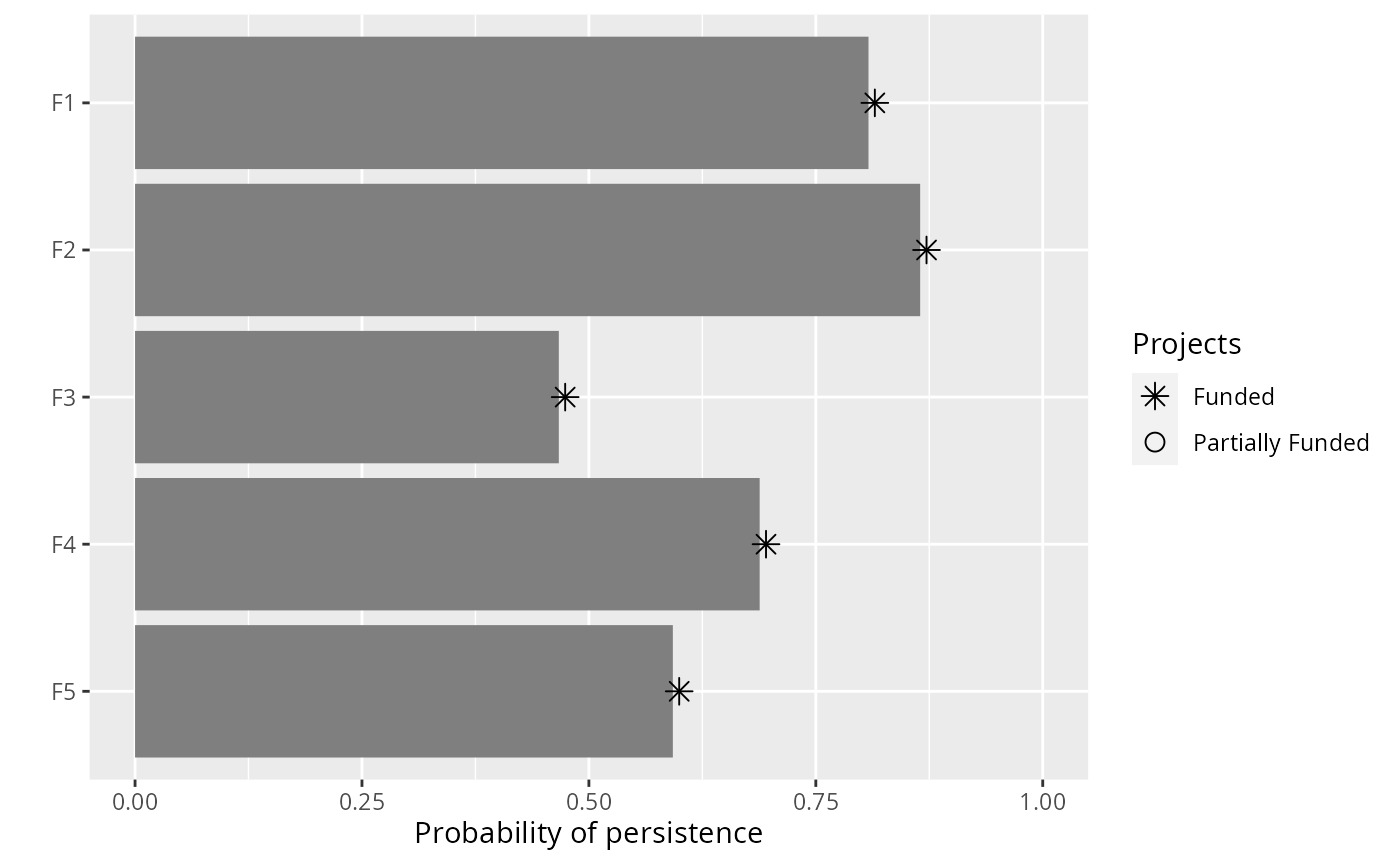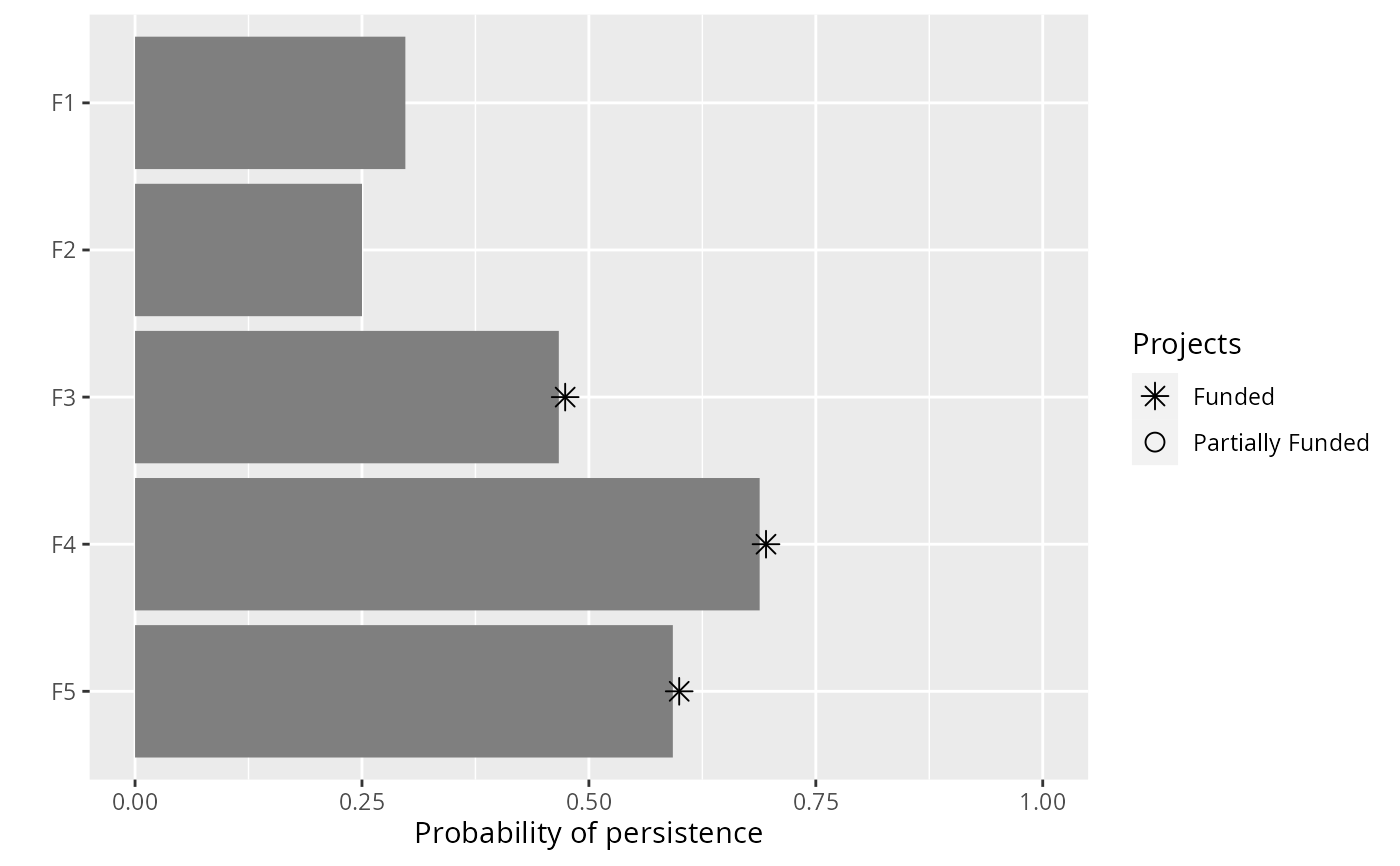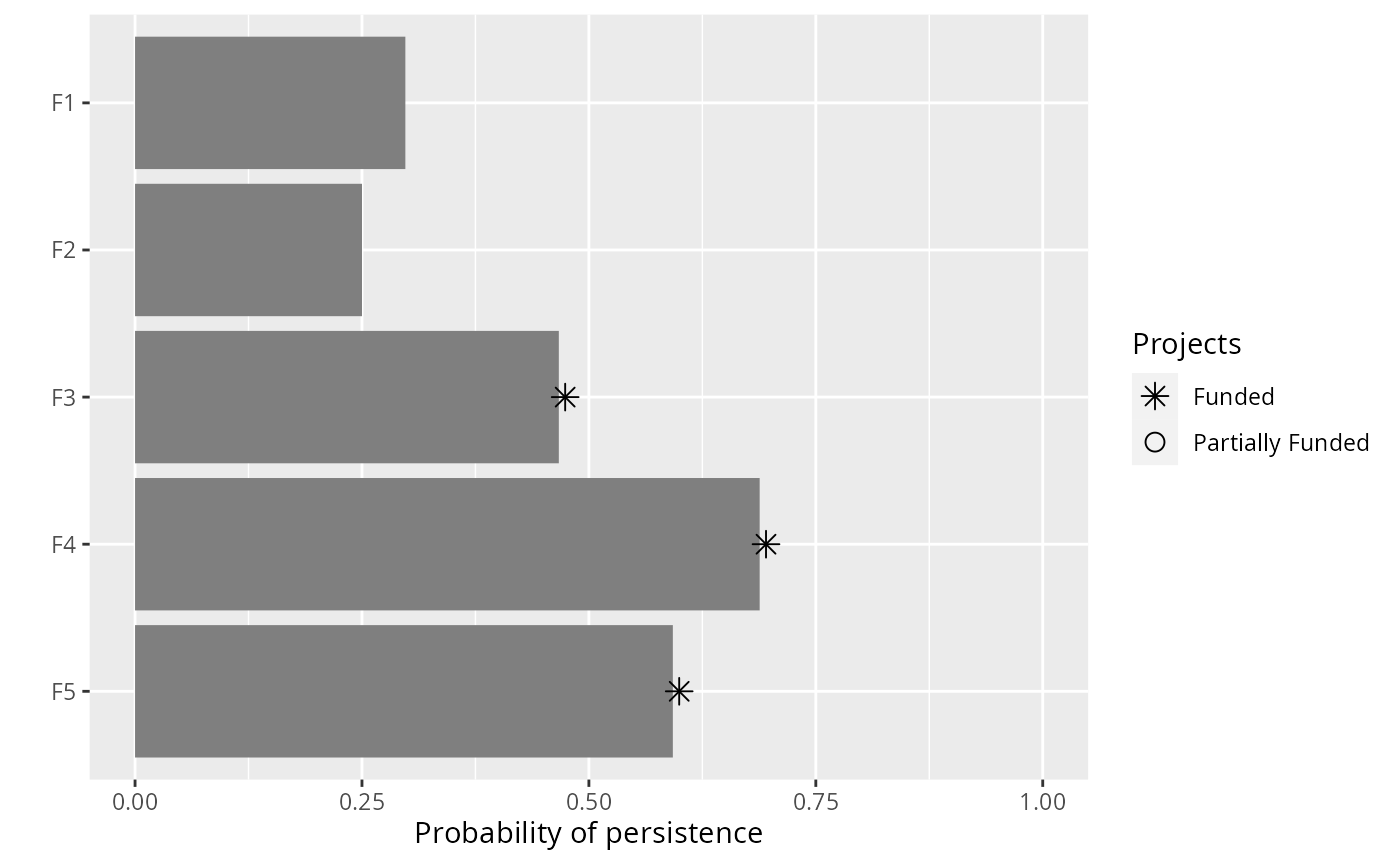Set targets for a project prioritization problem() by
specifying exactly what probability of persistence is required
for each feature. For instance, setting an absolute target of 10%
(i.e. 0.1) corresponds to a threshold 10% probability of persisting.
add_absolute_targets(x, targets)
# S4 method for ProjectProblem,numeric
add_absolute_targets(x, targets)
# S4 method for ProjectProblem,character
add_absolute_targets(x, targets)Arguments
- x
ProjectProblem object.
- targets
Object that specifies the targets for each feature. See the Details section for more information.
Details
Targets are used to specify the minimum probability of persistence
for each feature in solutions. For minimum set objectives
(i.e. add_min_set_objective(), these targets
specify the minimum probability of persistence required for each species
in the solution. And for budget constrained objectives that use targets
(i.e.add_max_targets_met_objective()), these targets
specify the minimum threshold probability of persistence that needs to be
achieved to count the benefits for conserving these species.
Please note that attempting to solve problems with objectives that require
targets without specifying targets will throw an error.
The targets for a problem can be specified in several different ways:
numericvectorof target values for each feature. The order of the target values should correspond to the order of the features in the data used to create the argument tox. Additionally, for convenience, this type of argument can be a single value to assign the same target to each feature.characterspecifying the name of column in the feature data (i.e. the argument to
featuresin theproblem()function) that contains the persistence targets.
See also
Examples
# load data
data(sim_projects, sim_features, sim_actions)
# build problem with minimum set objective and targets that require each
# feature to have a 30% chance of persisting into the future
p1 <- problem(sim_projects, sim_actions, sim_features,
"name", "success", "name", "cost", "name") %>%
add_min_set_objective() %>%
add_absolute_targets(0.3) %>%
add_binary_decisions()
# print problem
print(p1)
#> Project Prioritization Problem
#> actions F1_action, F2_action, F3_action, ... (6 actions)
#> projects F1_project, F2_project, F3_project, ... (6 projects)
#> features F1, F2, F3, ... (5 features)
#> action costs: min: 0, max: 103.22583
#> project success: min: 0.81379, max: 1
#> objective: Minimum set objective
#> targets: Absolute targets [targets (min: 0.3, max: 0.3)]
#> weights: default
#> decisions Binary decision
#> constraints: <none>
#> solver: default
# build problem with minimum set objective and specify targets that require
# different levels of persistence for each feature
p2 <- problem(sim_projects, sim_actions, sim_features,
"name", "success", "name", "cost", "name") %>%
add_min_set_objective() %>%
add_absolute_targets(c(0.1, 0.2, 0.3, 0.4, 0.5)) %>%
add_binary_decisions()
# print problem
print(p2)
#> Project Prioritization Problem
#> actions F1_action, F2_action, F3_action, ... (6 actions)
#> projects F1_project, F2_project, F3_project, ... (6 projects)
#> features F1, F2, F3, ... (5 features)
#> action costs: min: 0, max: 103.22583
#> project success: min: 0.81379, max: 1
#> objective: Minimum set objective
#> targets: Absolute targets [targets (min: 0.1, max: 0.5)]
#> weights: default
#> decisions Binary decision
#> constraints: <none>
#> solver: default
# add a column name to the feature data with targets
sim_features$target <- c(0.1, 0.2, 0.3, 0.4, 0.5)
# build problem with minimum set objective and specify targets using
# column name in the feature data
p3 <- problem(sim_projects, sim_actions, sim_features,
"name", "success", "name", "cost", "name") %>%
add_min_set_objective() %>%
add_absolute_targets("target") %>%
add_binary_decisions()
# print problem
print(p3)
#> Project Prioritization Problem
#> actions F1_action, F2_action, F3_action, ... (6 actions)
#> projects F1_project, F2_project, F3_project, ... (6 projects)
#> features F1, F2, F3, ... (5 features)
#> action costs: min: 0, max: 103.22583
#> project success: min: 0.81379, max: 1
#> objective: Minimum set objective
#> targets: Absolute targets [targets (min: 0.1, max: 0.5)]
#> weights: default
#> decisions Binary decision
#> constraints: <none>
#> solver: default
# \dontrun{
# solve problems
s1 <- solve(p1)
#> Set parameter Username
#> Set parameter LicenseID to value 2599748
#> Set parameter TimeLimit to value 2147483647
#> Set parameter MIPGap to value 0
#> Set parameter NumericFocus to value 3
#> Set parameter Presolve to value 2
#> Set parameter Threads to value 1
#> Set parameter PoolSolutions to value 1
#> Set parameter PoolSearchMode to value 2
#> Academic license - for non-commercial use only - expires 2025-12-16
#> Gurobi Optimizer version 12.0.2 build v12.0.2rc0 (linux64 - "Ubuntu 24.04.2 LTS")
#>
#> CPU model: 11th Gen Intel(R) Core(TM) i7-1185G7 @ 3.00GHz, instruction set [SSE2|AVX|AVX2|AVX512]
#> Thread count: 4 physical cores, 8 logical processors, using up to 1 threads
#>
#> Non-default parameters:
#> TimeLimit 2147483647
#> MIPGap 0
#> LogToConsole 0
#> NumericFocus 3
#> Presolve 2
#> Threads 1
#> PoolSolutions 1
#> PoolSearchMode 2
#>
#> Optimize a model with 46 rows, 42 columns and 92 nonzeros
#> Model fingerprint: 0xde05e947
#> Variable types: 0 continuous, 42 integer (42 binary)
#> Coefficient statistics:
#> Matrix range [9e-02, 1e+00]
#> Objective range [9e+01, 1e+02]
#> Bounds range [1e+00, 1e+00]
#> RHS range [3e-01, 1e+00]
#> Found heuristic solution: objective 497.7671458
#> Presolve removed 45 rows and 20 columns
#> Presolve time: 0.00s
#> Presolved: 1 rows, 22 columns, 2 nonzeros
#> Variable types: 0 continuous, 22 integer (22 binary)
#>
#> Explored 0 nodes (0 simplex iterations) in 0.00 seconds (0.00 work units)
#> Thread count was 1 (of 8 available processors)
#>
#> Solution count 1: 497.767
#> No other solutions better than 497.767
#>
#> Optimal solution found (tolerance 0.00e+00)
#> Best objective 4.977671458279e+02, best bound 4.977671458279e+02, gap 0.0000%
s2 <- solve(p2)
#> Set parameter Username
#> Set parameter LicenseID to value 2599748
#> Set parameter TimeLimit to value 2147483647
#> Set parameter MIPGap to value 0
#> Set parameter NumericFocus to value 3
#> Set parameter Presolve to value 2
#> Set parameter Threads to value 1
#> Set parameter PoolSolutions to value 1
#> Set parameter PoolSearchMode to value 2
#> Academic license - for non-commercial use only - expires 2025-12-16
#> Gurobi Optimizer version 12.0.2 build v12.0.2rc0 (linux64 - "Ubuntu 24.04.2 LTS")
#>
#> CPU model: 11th Gen Intel(R) Core(TM) i7-1185G7 @ 3.00GHz, instruction set [SSE2|AVX|AVX2|AVX512]
#> Thread count: 4 physical cores, 8 logical processors, using up to 1 threads
#>
#> Non-default parameters:
#> TimeLimit 2147483647
#> MIPGap 0
#> LogToConsole 0
#> NumericFocus 3
#> Presolve 2
#> Threads 1
#> PoolSolutions 1
#> PoolSearchMode 2
#>
#> Optimize a model with 46 rows, 42 columns and 92 nonzeros
#> Model fingerprint: 0x4e7d2c3e
#> Variable types: 0 continuous, 42 integer (42 binary)
#> Coefficient statistics:
#> Matrix range [9e-02, 1e+00]
#> Objective range [9e+01, 1e+02]
#> Bounds range [1e+00, 1e+00]
#> RHS range [1e-01, 1e+00]
#> Found heuristic solution: objective 403.3678534
#> Presolve removed 31 rows and 14 columns
#> Presolve time: 0.00s
#> Presolved: 15 rows, 28 columns, 30 nonzeros
#> Variable types: 0 continuous, 28 integer (28 binary)
#> Root relaxation presolved: 6 rows, 19 columns, 12 nonzeros
#>
#>
#> Root relaxation: objective 3.023765e+02, 0 iterations, 0.00 seconds (0.00 work units)
#>
#> Nodes | Current Node | Objective Bounds | Work
#> Expl Unexpl | Obj Depth IntInf | Incumbent BestBd Gap | It/Node Time
#>
#> * 0 0 0 302.3764827 302.37648 0.00% - 0s
#>
#> Explored 1 nodes (0 simplex iterations) in 0.00 seconds (0.00 work units)
#> Thread count was 1 (of 8 available processors)
#>
#> Solution count 1: 302.376
#> No other solutions better than 302.376
#>
#> Optimal solution found (tolerance 0.00e+00)
#> Best objective 3.023764827378e+02, best bound 3.023764827378e+02, gap 0.0000%
s3 <- solve(p3)
#> Set parameter Username
#> Set parameter LicenseID to value 2599748
#> Set parameter TimeLimit to value 2147483647
#> Set parameter MIPGap to value 0
#> Set parameter NumericFocus to value 3
#> Set parameter Presolve to value 2
#> Set parameter Threads to value 1
#> Set parameter PoolSolutions to value 1
#> Set parameter PoolSearchMode to value 2
#> Academic license - for non-commercial use only - expires 2025-12-16
#> Gurobi Optimizer version 12.0.2 build v12.0.2rc0 (linux64 - "Ubuntu 24.04.2 LTS")
#>
#> CPU model: 11th Gen Intel(R) Core(TM) i7-1185G7 @ 3.00GHz, instruction set [SSE2|AVX|AVX2|AVX512]
#> Thread count: 4 physical cores, 8 logical processors, using up to 1 threads
#>
#> Non-default parameters:
#> TimeLimit 2147483647
#> MIPGap 0
#> LogToConsole 0
#> NumericFocus 3
#> Presolve 2
#> Threads 1
#> PoolSolutions 1
#> PoolSearchMode 2
#>
#> Optimize a model with 46 rows, 42 columns and 92 nonzeros
#> Model fingerprint: 0x4e7d2c3e
#> Variable types: 0 continuous, 42 integer (42 binary)
#> Coefficient statistics:
#> Matrix range [9e-02, 1e+00]
#> Objective range [9e+01, 1e+02]
#> Bounds range [1e+00, 1e+00]
#> RHS range [1e-01, 1e+00]
#> Found heuristic solution: objective 403.3678534
#> Presolve removed 31 rows and 14 columns
#> Presolve time: 0.00s
#> Presolved: 15 rows, 28 columns, 30 nonzeros
#> Variable types: 0 continuous, 28 integer (28 binary)
#> Root relaxation presolved: 6 rows, 19 columns, 12 nonzeros
#>
#>
#> Root relaxation: objective 3.023765e+02, 0 iterations, 0.00 seconds (0.00 work units)
#>
#> Nodes | Current Node | Objective Bounds | Work
#> Expl Unexpl | Obj Depth IntInf | Incumbent BestBd Gap | It/Node Time
#>
#> * 0 0 0 302.3764827 302.37648 0.00% - 0s
#>
#> Explored 1 nodes (0 simplex iterations) in 0.00 seconds (0.00 work units)
#> Thread count was 1 (of 8 available processors)
#>
#> Solution count 1: 302.376
#> No other solutions better than 302.376
#>
#> Optimal solution found (tolerance 0.00e+00)
#> Best objective 3.023764827378e+02, best bound 3.023764827378e+02, gap 0.0000%
# print solutions
print(s1)
#> # A tibble: 1 × 21
#> solution status obj cost F1_action F2_action F3_action F4_action F5_action
#> <int> <chr> <dbl> <dbl> <dbl> <dbl> <dbl> <dbl> <dbl>
#> 1 1 OPTIMAL 498. 498. 1 1 1 1 1
#> # ℹ 12 more variables: baseline_action <dbl>, F1_project <dbl>,
#> # F2_project <dbl>, F3_project <dbl>, F4_project <dbl>, F5_project <dbl>,
#> # baseline_project <dbl>, F1 <dbl>, F2 <dbl>, F3 <dbl>, F4 <dbl>, F5 <dbl>
print(s2)
#> # A tibble: 1 × 21
#> solution status obj cost F1_action F2_action F3_action F4_action F5_action
#> <int> <chr> <dbl> <dbl> <dbl> <dbl> <dbl> <dbl> <dbl>
#> 1 1 OPTIMAL 302. 302. 0 0 1 1 1
#> # ℹ 12 more variables: baseline_action <dbl>, F1_project <dbl>,
#> # F2_project <dbl>, F3_project <dbl>, F4_project <dbl>, F5_project <dbl>,
#> # baseline_project <dbl>, F1 <dbl>, F2 <dbl>, F3 <dbl>, F4 <dbl>, F5 <dbl>
print(s3)
#> # A tibble: 1 × 21
#> solution status obj cost F1_action F2_action F3_action F4_action F5_action
#> <int> <chr> <dbl> <dbl> <dbl> <dbl> <dbl> <dbl> <dbl>
#> 1 1 OPTIMAL 302. 302. 0 0 1 1 1
#> # ℹ 12 more variables: baseline_action <dbl>, F1_project <dbl>,
#> # F2_project <dbl>, F3_project <dbl>, F4_project <dbl>, F5_project <dbl>,
#> # baseline_project <dbl>, F1 <dbl>, F2 <dbl>, F3 <dbl>, F4 <dbl>, F5 <dbl>
# plot solutions
plot(p1, s1)
 plot(p2, s2)
plot(p2, s2)
 plot(p3, s3)
plot(p3, s3)
 # }
# }